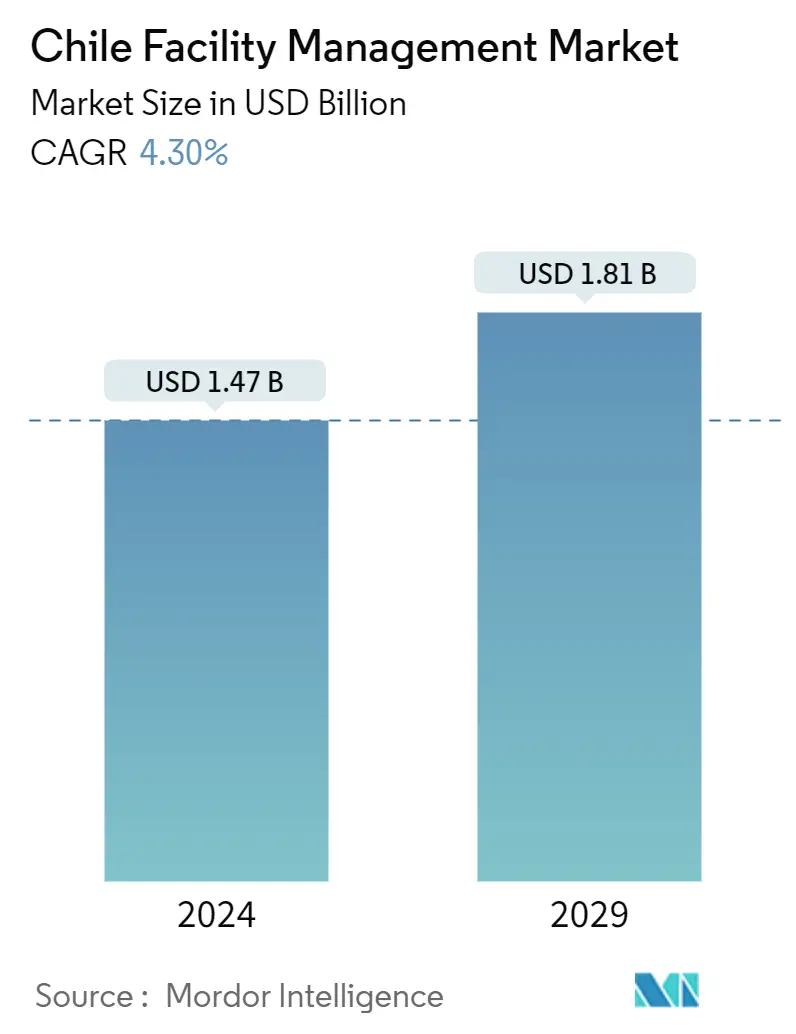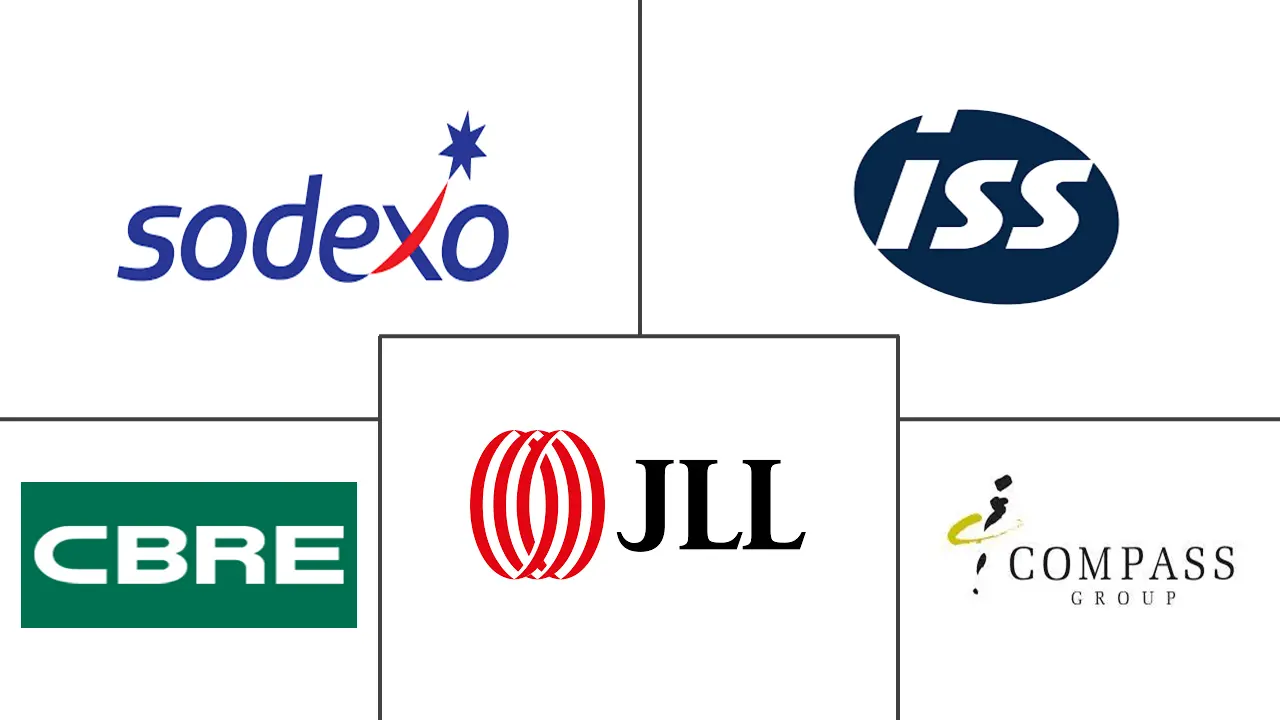Market Size of Chile Facility Management Industry

| Study Period | 2019 - 2029 |
| Base Year For Estimation | 2023 |
| Market Size (2024) | USD 1.47 Billion |
| Market Size (2029) | USD 1.81 Billion |
| CAGR (2024 - 2029) | 4.30 % |
| Market Concentration | Medium |
Major Players
*Disclaimer: Major Players sorted in no particular order |
Chile Facility Management Market Analysis
The Chile Facility Management Market size is estimated at USD 1.47 billion in 2024, and is expected to reach USD 1.81 billion by 2029, growing at a CAGR of 4.30% during the forecast period (2024-2029).
- The government-led construction initiatives in public infrastructure projects and the growing emphasis on green building practices are fuelling the demand for facility management in the country. Also, the rapid growth of the tourism industry is witnessing the increased demand for FM services in the country from the hotels, resorts, and accommodations facilities.
- Furthermore, the steady growth of commercial and industrial development is projected to support market growth, creating the need for both hard and soft services, as well as increased investor activity, cost control initiatives, adoption of sustainable practices, and technological advancements to contribute to the market growth.
- The low awareness of the benefits of integrated facility management is hampering the facility management market's growth. The presence of the local business environment is a significant challenge, leading them to shift from managing facilities from an in-house model to depending on professional firms.
- As part of expansion strategy from different sectors, several companies are expanding their international presence and establishing new offices. For instance, in April 2022, Globant, an IT and Software company, opened its new office in Santiago, with more than 3000 m2. Furthermore, the company planned to have three offices in the country by the end of the year.
- The pandemic also called for a renewed view on hygiene and has highlighted the need for FM services, such as cleaning, disinfecting, and sanitization. The demand for specialized area-based services has increased. Post-pandemic, as restrictions are being eased across the globe, FM players witness a significant rise in demand for professional sanitization and disinfection services from commercial entities.
Chile Facility Management Industry Segmentation
Facility management confines multiple disciplines to ensure buildings' functionality, comfort, safety, and efficiency by integrating people, place, process, and technology. While hard services include physical and structural services, such as fire alarm system lifts, among other services, soft services include cleaning, landscaping, security, and similar human-sourced services, providing a solution to end-user industries.
The Chile Facility Management Market is Segmented by Facility Management Type (In-house FM Service and Outsourced FM Service (Single FM, Bundled FM, and Integrated FM)), Offering Type (Hard FM and Soft FM), and End User (Commercial, Institutional, Public/ Infrastructure, and Industrial). The report offers the market size in value terms in USD for all the abovementioned segments.
The study also tracks the key market parameters, underlying growth influencers, and major vendors operating in the industry, which supports the market estimations and growth rates over the forecast period. The study also tracks the revenue accrued from various facility management types used in various end-user industries across Chile. In addition, the study provides the Chilean facility management market trends, along with key vendor profiles. The study further analyses the overall impact of COVID-19 on the ecosystem.
| By Facility Management Type | |||||
| In-house Facility Management | |||||
|
| By Offering | |
| Hard FM | |
| Soft FM |
| By End User | |
| Commercial | |
| Institutional | |
| Public/Infrastructure | |
| Industrial | |
| Other End Users |
Chile Facility Management Market Size Summary
The facility management market in Chile is poised for growth, driven by government-led infrastructure projects and a burgeoning tourism industry. The emphasis on green building practices and the rapid expansion of commercial and industrial developments are further propelling the demand for facility management services. Despite challenges such as low awareness of integrated facility management benefits and a shift from in-house to professional management models, the market is witnessing increased investor activity and technological advancements. The post-pandemic focus on hygiene has also heightened the demand for specialized FM services, including cleaning and sanitization, particularly in the tourism and hospitality sectors.
The public infrastructure segment, encompassing federal, state, and local office buildings, along with transportation facilities, is a significant contributor to market growth. The Chilean government's infrastructure plan and initiatives like "Let's Invest in Chile" are expected to attract substantial investments, creating opportunities for facility management vendors. The market is moderately consolidated, with key players like CBRE Group, JLL Limited, and ISS Chile actively participating. Strategic partnerships and expansions, such as those by Globant and Sodexo, are indicative of the market's dynamic nature. The growth of data centers and retail spaces, exemplified by ClaroVTR and IKEA's expansions, further underscores the increasing demand for FM services in the country.
Chile Facility Management Market Size - Table of Contents
-
1. MARKET INSIGHTS
-
1.1 Market Overview
-
1.2 Industry Attractiveness - Porter's Five Forces Analysis
-
1.2.1 Bargaining Power of Suppliers
-
1.2.2 Bargaining Power of Buyers
-
1.2.3 Threat of New Entrants
-
1.2.4 Threat of Substitutes
-
1.2.5 Intensity of Competitive Rivalry
-
-
1.3 Impact of COVID-19 on the Chilean Facility Management Market
-
-
2. MARKET SEGMENTATION
-
2.1 By Facility Management Type
-
2.1.1 In-house Facility Management
-
2.1.2 Outsourced Facility Management
-
2.1.2.1 Single FM
-
2.1.2.2 Bundled FM
-
2.1.2.3 Integrated FM
-
-
-
2.2 By Offering
-
2.2.1 Hard FM
-
2.2.2 Soft FM
-
-
2.3 By End User
-
2.3.1 Commercial
-
2.3.2 Institutional
-
2.3.3 Public/Infrastructure
-
2.3.4 Industrial
-
2.3.5 Other End Users
-
-
Chile Facility Management Market Size FAQs
How big is the Chile Facility Management Market?
The Chile Facility Management Market size is expected to reach USD 1.47 billion in 2024 and grow at a CAGR of 4.30% to reach USD 1.81 billion by 2029.
What is the current Chile Facility Management Market size?
In 2024, the Chile Facility Management Market size is expected to reach USD 1.47 billion.

